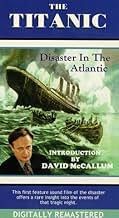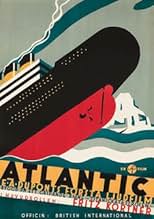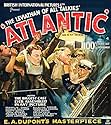Ajouter une intrigue dans votre langueOn its maiden voyage in April 1912, the supposedly unsinkable RMS Titanic hits an iceberg in the Atlantic Ocean.On its maiden voyage in April 1912, the supposedly unsinkable RMS Titanic hits an iceberg in the Atlantic Ocean.On its maiden voyage in April 1912, the supposedly unsinkable RMS Titanic hits an iceberg in the Atlantic Ocean.
- Réalisation
- Scénario
- Casting principal
Gordon James
- Capt. Collins
- (as Sydney Lynn)
Avis à la une
Yes I know "talkies" had just been invented for the cinema 2 years earlier when this was produced in 1929 but this film showed that much had to learnt about the art of producing films.It comes over as a filmed "hammy" stage play with the actors melodramatically enunciating their lines,rolling their eyes, using too many pregnant pauses and using gestures more appropriate to silent cinema, which I suppose was normal during the process of educating them to appear more naturalistic on screen.The gaps between lines spoken should have been tightened up during editing as it considerably slows the film.It is now only of interest for Titanic buffs who want to see an early example of this marine accident on film.In next chronological order they could see "Titanic" (1953) A Night to Remember (1958)"Titanic (1997), to see how the cinema's depiction of this tragedy as evolved over the years.There have been many documentaries and TV films made including the atrocious "SOS Titanic" (1979) On my version which is a DVD, David McCallum gives the introduction.It was he who played Harold Bride Marconi's junior wireless operator in "A Night to Remember"(still the best feature film - please read my "Tribute to Walter" comments on IMDb under Howard Morley.demon.co.uk)and gave the commentary on the series of 4 videos entitled "End of a Dream" so he was well qualified to give the narration.Of more interest I found was a recording accompanied by actual photos of the 1912 US Senate hearing which is also on the DVD.Actors speak the actual words spoken by Lightoller 2nd officer, J Bruce Ismay,Managing director of White Star, Harold Bride and others including Gloria Stewart (The "old Rose" in Titanic 1997) whose voice is used for one of the first class women survivors.
How interesting that E.A. Dupont who created one of germany's most memorable silent films (VARIETY) also helmed one of England's first talkies. Obviously he was uneasy with the medium of talking pictures, note how the first 6 minutes of this film is entirely visual. Most of the cast had stage experience, you can tell because they over-exaggerate their lines and cannon out the words like they were playing to the back row. Still this is a well paced dramatic film and the final few minutes have an impact that can stand on their own alongside the later versions, TITANIC and A NIGHT TO REMEMBER. (I am deliberately excluding James Cameron's film with its budget that would have fed a 3rd World country for 10 years and its plethora of computer FX.)
No movie with Madeleine Carroll in its cast could possibly be unwatchable. That said, I have to add that this British film comes close. The story takes place on board the `SS Atlantic' and it's loosely based on the `Titanic's' unfinished voyage. The word `unsinkable' is spoken, the liner strikes an iceberg, and we hear a heavenly choir sing `Nearer My God to Thee.' The doomed passengers eventually take over the anthem, in a clever bit of sound work. But the year of the film's release (1929) means that a modern viewer has to accept otherwise primitive sound and many of the acting conventions of silent films and the stage. These aren't problems. The film's major flaw is pacing, and pacing had been well developed in silents. However, if the dialog were delivered at a realistic speed, the movie's running time would be cut in half. The intended effect was drama (and clarity in a new medium), but the result unhappily is tiresome now. The film's structure is preposterously illogical and inept. Paradoxically, I found certain details of the editing quite modern in technique: fine, abrupt cuts from one area of the ship to another, sometimes even on sound effects. Although we're on board the `Atlantic' from the first shot, we were well over 4 minutes into the movie before I discovered that fact. There are long, intrusive musical passages by the ship's dance orchestra. (Entertaining, easy sound.) Personal stories are presented in an utterly uninvolving and unconvincing way. Don't even think of spectacle. The berg is a tiny thing and the exterior damage it does to the ship's hull is a minor dent. However, the scenes of passengers swarming into the lifeboats - clearly staged on a real liner, presumably tied up to a dock - generate great excitement. Other than the glorious Miss Carroll, these sequences are the film's only points of excellence. As the movie and the ship near their end, the screen goes totally black several times when the power generators begin to fail. Their last, eternal blackout is the end of the film, with a sunset/sunrise tacked on, a clumsy symbolic effect. `Atlantic' is a cinema curiosity. At best.
let me firstly say that too many of these reviewers ,particularly the film student,are viewing the film in a modern context and not as a film made at the coming of sound.In an interview given by John Longden for the BBCs programme "Yesterdays witness" he stated that the ridiculously long pauses between dialogue were entirely the idea of the director.So it is unfair to blame the actors for this.Also in that same programme sound men were interviewed.They said that the effects were recorded on a liner berthed at Tilbury.The ship was linked by phone line to Elstree studios.Before each effect someone would come on the line to describe the effect and it would be recorded at Elstree.The problems with early sound films were quite apparent here.few directors here or in America had the skill of Hitchcock in adapting to the new medium.In fact one should praise the attempt to tell the story in what was then effectively a new medium rather than decry the effort some 84 years later because it is old fashioned.no doubt in the year 2097 young film students will be looking at the like of Man of Steel and chuckling at its antique quaintness.
I was very surprised that I found this 1929 film on YouTube today.. I had no idea it existed and I was excited to see a talking picture made only a decade and a half after the disaster. However, my excitement turned out to be rather muted, as instead of having a grand scope (as ANY picture about the Titanic should have), it looks amazingly claustrophobic. Despite the ship having about 3300 folks aboard (counting crew and passengers), you mostly see scenes with a small handful of folks in them!! I think this is for two reasons. First, the film was obviously made on the cheap. Second, 1929 was the first year for sound pictures in the UK and like the earlier American films of 1927-28, the sound technology was primitive and they had no idea how to film large rooms full of people. Instead, folks had to stand around hidden microphones and talk...which seems unnatural when you see such movies.
As for the title, apparently the White Star Line had a lot of nerve and wouldn't allow the studio to use the name 'Titanic'. I am no barrister, so I have no idea about British law, but this seems more a ploy by White Star than a legitimate case where a copyright or trademark is involved. The sinking of the Titanic was a historical event and mentioning this and the ship's name seem reasonable...and I am not sure why the studio caved and named the movie 'Atlantic' instead of 'Titanic'...but they did.
One thing that was bad about the movie but isn't the filmmakers' fault is that the print is rather jerky and it jiggles a bit. You probably won't need Dramamine to watch the picture, but it is noticeable and annoying.
Another thing to note is that there apparently were several versions of the movie. In the earliest days of sound, they studios had no idea how to dub films into other languages...so they filmed multiple versions in various languages. Laurel & Hardy did this, the Bela Lugosi version of "Dracula" has another version starring a Mexican count and with "Atlantic", they filmed it in German, English AND as a silent (as most theaters didn't have the technology to play sound films yet). And, after finishing the filming, the film was re-cut and French language scenes were added. I saw the English language version...and have no idea if these other versions even exist today nor where you can find them if they do exist.
The movie is odd in that it just begins on the ship in a small drawing room just before the ill-fated crash. I checked...the print I saw WAS the entire 90 minute picture and the normal introduction apparently just wasn't made. This provided little in the way of suspense and over an hour of the film consists of what happens after the ship collides with an iceberg. And, since it was made with very few extras and cast, the whole thing seems a bit small and anticlimactic. But I do cut the film some slack because of when it was made....expecting the same spectacle as in the Nazi propaganda film "Titanic" (1943) or "A Night to Remember" (1958) or "Titanic" (1997) would be ridiculous. Cramped productions were certainly the norm until about 1930-31....and, in hindsight, it might have worked better had they just waited a year or so to make the movie. Additionally, the film lacks reasonably well developed characters and even for 1929, it was a bit of a disappointment in this regard. So, overall it's a very mixed bag for 1929...and a film that must have impressed back in the day but which became quickly dated as well. Mostly of value to the curious and film historians. I give it a 5 because it is watchable and some of the scenes were well made...but overall, it is disappointing and cramped!
As for the title, apparently the White Star Line had a lot of nerve and wouldn't allow the studio to use the name 'Titanic'. I am no barrister, so I have no idea about British law, but this seems more a ploy by White Star than a legitimate case where a copyright or trademark is involved. The sinking of the Titanic was a historical event and mentioning this and the ship's name seem reasonable...and I am not sure why the studio caved and named the movie 'Atlantic' instead of 'Titanic'...but they did.
One thing that was bad about the movie but isn't the filmmakers' fault is that the print is rather jerky and it jiggles a bit. You probably won't need Dramamine to watch the picture, but it is noticeable and annoying.
Another thing to note is that there apparently were several versions of the movie. In the earliest days of sound, they studios had no idea how to dub films into other languages...so they filmed multiple versions in various languages. Laurel & Hardy did this, the Bela Lugosi version of "Dracula" has another version starring a Mexican count and with "Atlantic", they filmed it in German, English AND as a silent (as most theaters didn't have the technology to play sound films yet). And, after finishing the filming, the film was re-cut and French language scenes were added. I saw the English language version...and have no idea if these other versions even exist today nor where you can find them if they do exist.
The movie is odd in that it just begins on the ship in a small drawing room just before the ill-fated crash. I checked...the print I saw WAS the entire 90 minute picture and the normal introduction apparently just wasn't made. This provided little in the way of suspense and over an hour of the film consists of what happens after the ship collides with an iceberg. And, since it was made with very few extras and cast, the whole thing seems a bit small and anticlimactic. But I do cut the film some slack because of when it was made....expecting the same spectacle as in the Nazi propaganda film "Titanic" (1943) or "A Night to Remember" (1958) or "Titanic" (1997) would be ridiculous. Cramped productions were certainly the norm until about 1930-31....and, in hindsight, it might have worked better had they just waited a year or so to make the movie. Additionally, the film lacks reasonably well developed characters and even for 1929, it was a bit of a disappointment in this regard. So, overall it's a very mixed bag for 1929...and a film that must have impressed back in the day but which became quickly dated as well. Mostly of value to the curious and film historians. I give it a 5 because it is watchable and some of the scenes were well made...but overall, it is disappointing and cramped!
Le saviez-vous
- AnecdotesThe White Star Line forbade the production company from referring to the ship in this film as The Titanic.
- GaffesThe women's hairstyle and dresses are from 1929.
- Versions alternativesReleased with separate English, French and German soundtracks.
- ConnexionsAlternate-language version of Atlantik (1929)
- Bandes originalesWalking With Susie
(uncredited)
Written by G.H. Elliott
Played by the ship's band as Larry and Monica enter the Smoking Room.
Meilleurs choix
Connectez-vous pour évaluer et suivre la liste de favoris afin de recevoir des recommandations personnalisées
Détails
- Date de sortie
- Pays d’origine
- Langue
- Aussi connu sous le nom de
- Titanic: Disaster in the Atlantic
- Lieux de tournage
- Société de production
- Voir plus de crédits d'entreprise sur IMDbPro
Box-office
- Budget
- 2 000 £GB (estimé)
- Durée1 heure 30 minutes
- Couleur
- Rapport de forme
- 1.20 : 1
Contribuer à cette page
Suggérer une modification ou ajouter du contenu manquant




































